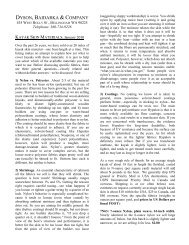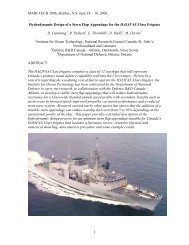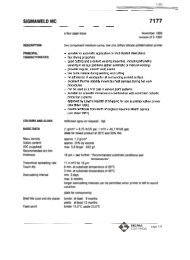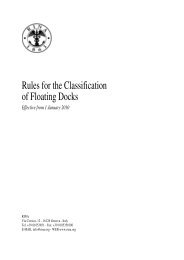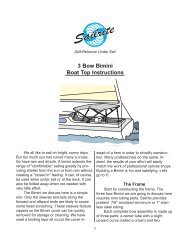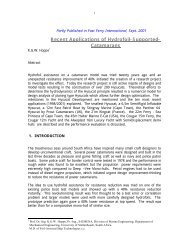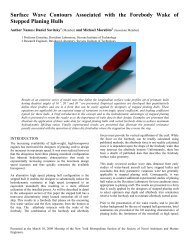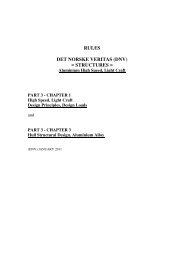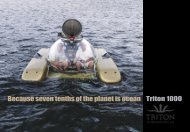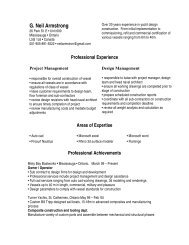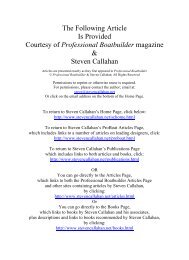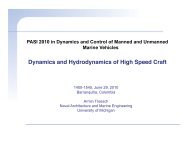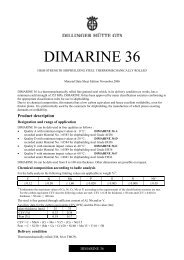Pt C, Ch 1, Sec 1<strong>SECTION</strong> 1GENERAL REQUIREMENTS AND APPLICATION1 General1.1 Application1.1.1 Chapter 1 applies to the design, construction, installation,tests and trials of main propulsion and essential auxiliarymachinery systems and associated equipment,pressure vessels, piping systems, and steering and manoeuvringsystems installed on board classed yachts, as indicatedin each Section of this Chapter and as far as class isconcerned only.Where the word yachts is used in the subsequent chapter, itmeans yachts and charter yachts.1.1.2 In the present Chapter, length reference to 24 mmeans:• for yacht: Hull length, L h , as defined in EC Directive (ENISO standard 8666:2002) reminded in Pt A, Ch 2, Sec1, [2.2.1]• for charter yacht: Length according to InternationalRules, L LL , as defined in Pt A, Ch 2, Sec 1, [2.2.1].1.2 Statutory requirements1.2.1 Attention is to be paid to any relevant statutoryrequirements of the National Authority of the country inwhich the yacht is to be registered, as stated in Part A.In particular, no specific requirements related to preventionof marine pollution are included in the present Rules.1.3 Documentation to be submitted1.3.1 Before the actual construction is commenced, theManufacturer, <strong>Design</strong>er or yacht builder is to submit to theSociety the documents (plans, diagrams, specifications andcalculations) requested in the relevant Sections of thisChapter.1.4 Definitions1.4.1 Engine spaceOn yachts of less than 24m in length, the engine space isthe space or compartment of the yacht containing main orauxiliary engine(s).1.4.2 Machinery spacesOn yachts of 24 m in length and over, machinery spaces aremachinery spaces of category A and other spaces containingpropulsion machinery, boilers, oil fuel units, steam andinternal combustion engines, generators and major electricalmachinery, oil filling stations, refrigerating, stabilizing,ventilation and air conditioning machinery, and similarspaces, and trunks to such spaces.1.4.3 Machinery spaces of category AOn yachts of 24 m in length and over, machinery spaces ofcategory A are those spaces and trunks to such spaceswhich contain either:a) internal combustion machinery used for main propulsion,orb) internal combustion machinery used for purposes otherthan main propulsion where such machinery has in theaggregate a total power output of not less than 375 kW,orc) any oil-fired boiler or oil fuel unit, or any oil-firedequipment other than boilers, such as inert gas generators,incinerators, etc.1.4.4 Fuel oil unitFuel oil unit is the equipment used for the preparation offuel oil for delivery to an oil fired boiler, or equipment usedfor the preparation for delivery of heated oil to an internalcombustion engine, and includes any oil pressure pumps,filters and heaters dealing with oil at a pressure of morethan 0,18 N/mm 2 .1.4.5 Continuity of serviceThe Shipyard is to give special consideration to the reliabilityof single essential propulsion components. This mayrequire a separate source of propulsion power sufficient togive the yacht a navigable speed, especially in the case ofunconventional arrangements.2 <strong>Design</strong> and construction2.1 General2.1.1 The machinery, pressure vessels, associated pipingsystems and fittings are to be of a design and constructionadequate for the service for which they are intended andare to be so installed and protected as to reduce to a minimumany danger to persons on board, due regard beingpaid to moving parts, hot surfaces and other hazards.The design is to have regard to materials used in construction,the purpose for which the equipment is intended, theworking conditions to which it will be subjected and theenvironmental conditions on board.2.2 Materials, welding and testing2.2.1 GeneralMaterials, welding and testing procedures are to be inaccordance with the requirements of the Rule Note NR216Materials and Welding and those given in the other Sectionsof this Chapter. In addition, for machinery components fabricatedby welding the requirements given in [2.2.2] apply.July 2006 with February 2008 Amendments Bureau Veritas Rules for Yachts 307
Pt C, Ch 1, Sec 1Table 1 : Inclination of yachtInstallations, componentsAngle of inclination (degrees) (1)AthwartshipFore and aftstatic dynamic static dynamicMain and auxiliary machinery 15 22,5 5 7,5Safety equipment, e.g. emergency power installations, emergency firepumps and their devicesSwitch gear, electrical and electronic appliances (4)and remote control systems22,5(2) (3)22,5(2) (3)10 10(1) Athwartship and fore-and-aft inclinations may occur simultaneously.(2) In sailing yachts, auxiliary engines must operate satisfactorily after being heeled to a larger angle of 30° a long time.(3) In sailing yachts, where main and/or auxiliary engines are intended to supply energy to a yacht sailing heeled a long time, thesubject engines must operate satisfactorily to an angle of 30°.(4) Up to an angle of inclination of 45° no undesired switching operations or operational changes may occur.2.2.2 Welded machinery componentsWelding processes and welders are to be approved by theSociety in accordance with the Rule Note NR216 Materialsand Welding, Chapter 5.References to welding procedures adopted are to be clearlyindicated on the plans submitted for approval.Joints transmitting loads are to be either:• full penetration butt-joints welded on both sides, exceptwhen an equivalent procedure is approved• full penetration T- or cruciform joints.For joints between plates having a difference in thicknessgreater than 3 mm, a taper having a length of not less than 4times the difference in thickness is required. Depending onthe type of stress to which the joint is subjected, a taperequal to three times the difference in thickness may beaccepted.T-joints on scalloped edges are not permitted.Lap-joints and T-joints subjected to tensile stresses are tohave a throat size of fillet welds equal to 0,7 times the thicknessof the thinner plate on both sides.In the case of welded structures including cast pieces, thelatter are to be cast with appropriate extensions to permitconnection, through butt-welded joints, to the surroundingstructures, and to allow any radiographic and ultrasonicexaminations to be easily carried out.Where required, preheating and stress relieving treatmentsare to be performed according to the welding procedurespecification.2.3 Vibrations2.3.1 Shipyards and manufacturers are to give special considerationto the design, construction and installation ofpropulsion machinery systems and auxiliary machinery sothat any mode of their vibrations shall not cause unduestresses in this machinery in the normal operating ranges.2.4 Operation in inclined position2.4.1 Main propulsion machinery and all auxiliary machineryessential to the propulsion and the safety of the yachtare, as fitted in the yacht, be designed to operate when theyacht is upright and when inclined at any angle of list eitherway and trim by bow or stern as stated in Tab 1.The Society may permit deviations from angles given in Tab1, taking into consideration the type, size and service conditionsof the yacht.Machinery with a horizontal rotation axis is generally to befitted on board with such axis arranged alongships. If this isnot possible, the Manufacturer is to be informed at the timethe machinery is ordered.2.5 Ambient conditions2.5.1 Machinery and systems covered by the Rules are tobe designed to operate properly under the ambient conditionsspecified in Tab 2, unless otherwise specified in eachSection of this Chapter.Table 2 : Ambient conditionsLocation, arrangementAIR TEMPERATURETemperature range (°C)In enclosed spaces between 0 and +45 (2)On machinery components,boilersIn spaces subject to higher orlower temperaturesAccording to specificlocal conditionsOn exposed decks between −25 and +45 (1)CoolantWATER TEMPERATURESea water or, if applicable, seawater at charge air coolant inletTemperature (°C)up to +32(1) Electronic appliances are to be designed for an air temperatureup to 55°C (for electronic appliances see alsoPart C, Chapter 2).(2) Different temperatures may be accepted by the Societyin the case of yachts intended for restricted service.308 Bureau Veritas Rules for Yachts July 2006 with February 2008 Amendments
- Page 1 and 2:
A-PDF Merger DEMO : Purchase from w
- Page 3 and 4:
Pt A, Ch 1, Sec 3SECTION 3SURVEYS1
- Page 5 and 6:
Pt A, Ch 1, Sec 5SECTION 5INTERVENT
- Page 7 and 8:
Pt A, Ch 2, Sec 1SECTION 1DEFINITIO
- Page 9 and 10:
Pt A, Ch 2, Sec 2Table 3 : Charter
- Page 11 and 12: Pt B, Ch 1, Sec 1SECTION 1APPLICATI
- Page 13 and 14: Pt B, Ch 1, Sec 2SECTION 2SYMBOLS A
- Page 15 and 16: Pt B, Ch 1, Sec 4SECTION 4CALCULATI
- Page 17 and 18: Pt B, Ch 10, Sec 5SECTION 5INDEPEND
- Page 19 and 20: Pt B, Ch 11, Sec 1SECTION 1GENERAL
- Page 21 and 22: Pt B, Ch 12, Sec 2SECTION 2RAW MATE
- Page 23 and 24: Pt B, Ch 12, Sec 2The chemical netw
- Page 25 and 26: Pt B, Ch 12, Sec 2This Carbon may u
- Page 27 and 28: Pt B, Ch 12, Sec 23.4 Homologation
- Page 29 and 30: Pt B, Ch 12, Sec 2Table 4 : BalsaVo
- Page 31 and 32: Pt B, Ch 12, Sec 2Table 6 : Meta-ar
- Page 33 and 34: Pt B, Ch 12, Sec 3SECTION 3INDIVIDU
- Page 35 and 36: Pt B, Ch 12, Sec 3Table 1 : Resin /
- Page 37 and 38: Pt B, Ch 12, Sec 3Table 4 : Element
- Page 39 and 40: Pt B, Ch 3, Sec 1c) Lightweight che
- Page 41 and 42: Pt B, Ch 3, Sec 2Figure 1 : Severe
- Page 43 and 44: Pt B, Ch 3, Sec 2where:F : Wind for
- Page 45 and 46: Pt B, Ch 3, App 2APPENDIX 2TRIM AND
- Page 47 and 48: Pt B, Ch 4, Sec 2SECTION 2DESIGN LO
- Page 49 and 50: Pt B, Ch 6, Sec 3SECTION 3SPECIFIC
- Page 51 and 52: Pt B, Ch 6, Sec 3Figure 2 : Rig loa
- Page 53 and 54: Pt B, Ch 7, Sec 1SECTION 1 HYDRODYN
- Page 55 and 56: Pt B, Ch 7, Sec 1Figure 4 : Load ar
- Page 57 and 58: Pt B, Ch 7, Sec 1• for monohull -
- Page 59 and 60: Pt B, Ch 7, Sec 2SECTION 2BOTTOM SL
- Page 61: Pt B, Ch 9, Sec 1SECTION 1GENERAL1
- Page 65: Pt C, Ch 1, Sec 13.4 Safety devices



